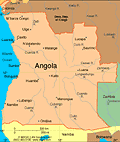Angola
Facts & Figures

-
President: José Eduardo dos Santos (1979)
Prime Minister: position abolished (2012)
Total area: 481,350 sq mi (1,246,699 sq km)
Population (2014 est.): 19,088,106 (growth rate: 2.78%); birth rate: 38.97/1000; infant mortality rate: 79.99/1000; life expectancy: 55.29
Capital and largest city (2011 est.): Luanda, 5.068 million
Other large cities: Huambo, 1.098 million
Monetary unit: New Kwanza
National name: Republica de Angola
Languages: Portuguese (official), Bantu and other African languages
Ethnicity/race: Ovimbundu 37%, Kimbundu 25%, Bakongo 13%, mestico (mixed European and Native African) 2%, European 1%, other 22%
Religions: Indigenous 47%, Roman Catholic 38%, Protestant 15% (1998 est.)
Literacy rate: 70.4% (2011 est.)
Economic summary: GDP/PPP (2013 est.): $131.8 billion; per capita $6,300. Real growth rate: 5.6%. Inflation: 8.9%. Unemployment: n.a. Arable land: 3.29%. Agriculture: bananas, sugarcane, coffee, sisal, corn, cotton, manioc (tapioca), tobacco, vegetables, plantains; livestock; forest products; fish. Labor force: 9.018 million; agriculture 85%, industry and services 15% (2003 est.). Industries: petroleum; diamonds, iron ore, phosphates, feldspar, bauxite, uranium, and gold; cement; basic metal products; fish processing; food processing, brewing, tobacco products, sugar; textiles; ship repair. Natural resources: petroleum, diamonds, iron ore, phosphates, copper, feldspar, gold, bauxite, uranium. Exports: $70.84 billion (2013 est.): crude oil, diamonds, refined petroleum products, gas, coffee, sisal, fish and fish products, timber, cotton. Imports: $26.09 billion (2013 est.): machinery and electrical equipment, vehicles and spare parts; medicines, food, textiles, military goods. Major trading partners: U.S., China, India, South Africa, Portugal, Brazil (2012)
Communications: Telephones: main lines in use: 303,000 (2012); mobile cellular: 9.8 million (2012). Broadcast media: state controls all broadcast media with nationwide reach; state-owned Televisao Popular de Angola (TPA) provides terrestrial TV service on 2 channels; a third TPA channel is available via cable and satellite; TV subscription services are available; state-owned Radio Nacional de Angola (RNA) broadcasts on 5 stations; about a half dozen private radio stations broadcast locally (2008). Internet hosts: 20,703 (2012). Internet users: 606,700 (2009).
Transportation: Railways: total: 2,764 km (2008). Highways: total: 51,429 km; paved: 5,349 km; unpaved: 46,080 km (2001). Waterways: 1,300 km (2011). Ports and harbors: Cabinda, Luanda, Lobito, Namibe. Airports: 176 (2013).
International disputes: Democratic Republic of Congo accuses Angola of shifting monuments.

